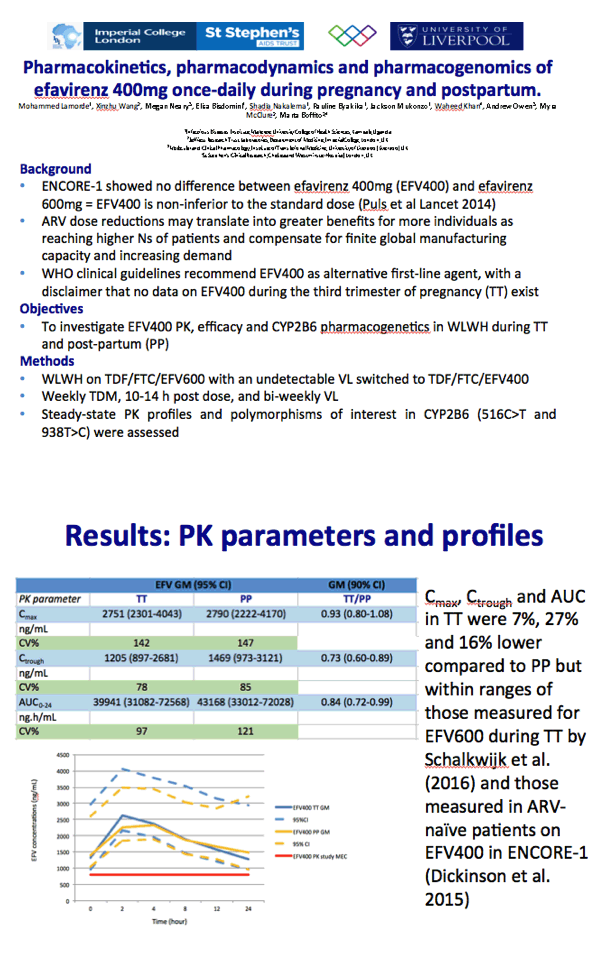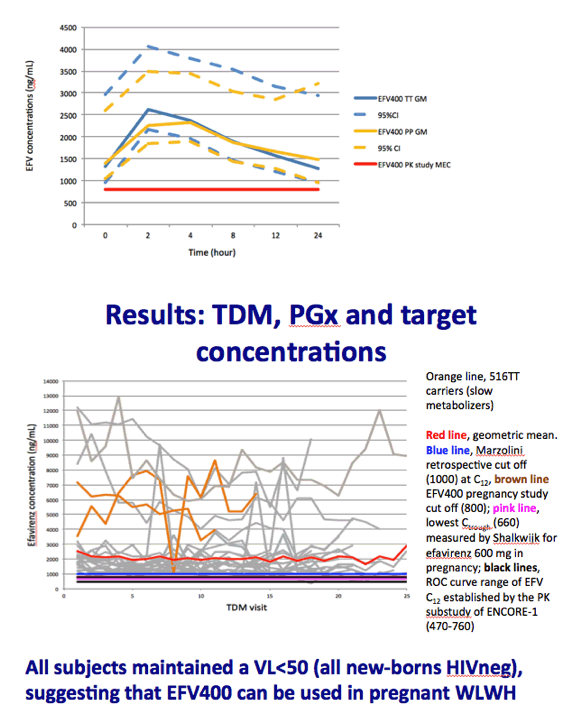 |
 |
 |
| |
Pharmacokinetics, pharmacodynamics and pharmacogenomics of efavirenz 400mg once-daily during pregnancy and postpartum
|
| |
| |
Reported by Jules Levin
9th IAS Conference on HIV Science; July 23-26, 2017; Paris, France
M. Lamorde1, X. Wang2, M. Neary3, E. Bisdomini4, S. Nakalema1, P. Byakika1, J. Mukonzo1, W. Khan4, A. Owen3, M. McClure2, M. Boffito2,4
Institutions
1IDI, Kampala, Uganda, 2Imperial College, London, United Kingdom, 3University of Liverpool, Liverpool, United Kingdom, 4SSCR, Chelsea and Westminster Hospital, London, United Kingdom
Background: Antiretroviral dose reductions may compensate for the finite global manufacturing capacity and allow access programmes to reach larger numbers of HIV-infected patients. The ENCORE-1 study showed that efavirenz 400mg (EFV400) is non-inferior to the standard adult dose. WHO clinical guidelines now recommend EFV400 as an alternative first-line agent, however with a disclaimer that no data on EFV400 during the third trimester of pregnancy (TT) exist. This study investigated the pharmacokinetics (PK), efficacy and CYP2B6 pharmacogenetics of EFV400 in women living with HIV (WLWH) during TT and post-partum (PP) with a view to removing the disclaimer and allowing wider EFV400 use in first-line.
Methods: Open-label, multicentre study (UK and Uganda) in WLWH receiving tenofovir disoproxil fumarate (TDF), emtricitabine (FTC) and EFV 600mg with an undetectable viral load (VL), who switched to TDF/FTC/EFV400 was performed. Weekly therapeutic drug monitoring (TDM), steady-state PK profiles during TT and PP, safety, virologic efficacy and polymorphisms in CYP2B6 (516C>T; 938T>C) were evaluated.
Results: 22 WLWH of African origin were enrolled, baseline median (range) age and CD4 were 30 (18-41) years and 548 (190-882) cells/mm3, respectively. All had VL< 50 copies/mL at baseline, which was maintained throughout the study (only 2 blips were observed but confirmed < 50, when repeated). None of the children were HIV-infected. No WLWH were excluded from the study because of low EFV400 TDM results (< 800 ng/mL in >3 consecutive visits). Geometric mean (GM) ratios (TT/PP; 90% confidence intervals) of EFV400 Cmax, AUC, and C24h were 0.86 (0.68-1.09), 0.74 (0.59-0.94), 0.62 (0.47-0.83). GM C24h was 1256 ng/mL (coefficient of variation 79%). 20/22 WLWH were carriers of the CYP2B6 516G allele and only 2 were slow metabolisers. EFV400 was well tolerated during pregnancy with no grade 3 or 4 laboratory abnormalities.
Conclusions: Cmax, AUC, and C24h in TT were 14%, 26% and 38% lower compared to PP but within ranges of those measured for EFV600 during TT by Schalkwijk et al. (2016) and those measured in ARV-naïve patients on EFV400 in ENCORE-1 (Dickinson et al. 2015). All subjects maintained a VL< 50, suggesting that EFV400 can be used in pregnant WLWH.
⋅The primary endpoint was the comparison of EFV Ctrough TT vs PP using geometric mean ratios (GMR). For this sequential design, a sample size of 25 patients would provide at least 80% power to detect a decrease in EFV400 Ctrough of 20% during TT vs PP. This calculation assumes two-sided testing with a 5% significance level and a within-patient coefficient of variation in EFV400 levels of no more than 30%.
⋅EFV400 PK parameters measure during TT and PP were compared by calculating GMR and 90% confidence intervals (CI).


|
| |
|
 |
 |
|
|